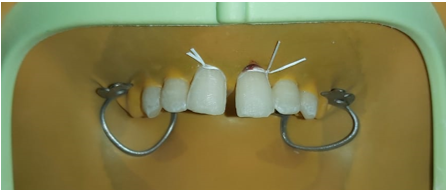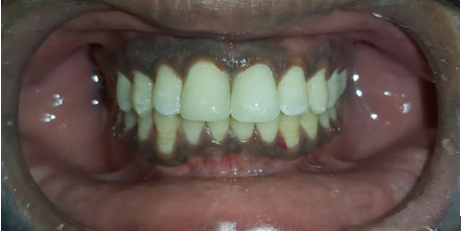Introduction
Maxillary midline diastema is a frequently occurring malocclusion found to be a common aesthetic complaint of patients. Keene described midline diastema as anterior midline spacing greater than 0.5 mm between the proximal surfaces of adjacent teeth.1 The incidence of midline diastemas varies with age and race.2 Higher prevalence of midline diastema has been reported in the maxilla than that of the mandible. Midline diastema can be caused by various conditions including 1. Developmental factors (microdontia, missing lateral, mesiodens, macroglossia, macro-hypertrophic fibro frenum), 2. Pathological factors (midline cyst, tumor, and periodontitis), and 3. Neuromuscular factors (oral habits such as tongue thrusting during the speech, swallowing, or abnormal pressure during rest.3, 4 Diastema leads to the dissension of the smile, disability of phonetics, and improper maintenance of oral hygiene.5 According to a study conducted in Finland, in order to evaluate the impact of an incisal malocclusion on the social attractiveness of young adults, it was concluded that patients with broad midline spacing were recognized to be socially unsuccessful and of lower intelligence.6, 7
A properly developed differential diagnosis permits the practitioner to choose the most effective treatment plan. The width-to-length ratio is an important factor in the decision-making of the treatment plan for aesthetic rehabilitation of a complex midline diastema. planning such as the amount of distal proximal reduction, the number of teeth to be treated, the placement and location of prominences and concavities to create the illusion, and the decision for full-veneers or just adding to the interproximal depends on that ratio.8 There are multiple treatment options for diastema based on the factors like time, and the physical, psychological, and economical condition of the patient.9, 10 There are various treatment options for the management of midline diastema, involving multidisciplinary approaches or via orthodontic therapy along with surgical approach or via restorative dentistry using direct composite restorations or ceramic veneers.11, 12
In restorative dentistry, diastema can be corrected using these techniques: Direct composite veneers, indirect composite veneers, porcelain laminate veneers, all ceramic crowns, metal-ceramic crowns, and composite crowns are the techniques used for the restorative management of diastema.6, 7 The increased consciousness of patients towards low encroaching aesthetic techniques and the upgraded physical properties of the composite materials have ensued in the substantial use of direct bonding of composite resin for the management of midline diastemas.13
The following case report presents the closure of midline diastema by direct composite resin restoration using a layering technique.
Case Presentation
A 25-year-old male patient reported to the Department of Conservative Dentistry and Endodontics, Mithila Minority Dental College and Hospital, Darbhanga, with a complaint of spacing in the upper front tooth region of the jaw. The patient’s medical history was non-contributory and on intraoral examination, a midline diastema of 3mm was revealed in the maxillary arch (Mesial to 11& 21) Past dental history revealed that the patient has undergone fixed orthodontic treatment 2 yrs. back. It seems to be a relapsed orthodontic treatment case according to the history given by the patient. On clinical and radiographic examinations there were no other findings. The direct aesthetic composite laminate veneer was considered as the treatment of choice for the build-up of both maxillary central incisors as a more conservative, inexpensive, aesthetic, and quicker option.
Figure 2
Maxillary anterior teeth were isolated with a rubber dam and retraction was done using dental floss. Window preparation was done on the labial surface of the tooth.

First of all, shade selection was done using VITAPAN classical (Germany). Then small blebs of composite restorative material were used for confirmation of selected shades. A2, A3 & A3.5 Composite shades (3M ESPE Filtek Z350) were applied on the labial surface of the tooth in small blebs form. A2 & A3 shades were selected for restorative procedure, once we are done with curing of blebs. Isolation was achieved using Dental Dam Kit (Coltene) and the central incisors were retracted by using dental floss (Figure 2).
Window preparation was done on the Labial surface of both the maxillary central incisors for direct composite veneers (Figure 2). The prepared tooth surface was etched for 15 seconds using 37% phosphoric acid, rinsed for 20 seconds, and air dried with slight air pressure. Bonding agent was applied (Adper single Bond, 3M ESPE, USA) and cured for 20 seconds using (Vivadent Blue phase) curing light. A3 shade was applied as a base layer and A2 shade was applied as the superficial layer. The labial surface of the restoration was flattened using red banded knife-edge tip diamond bur (Diatec, Coltene). The restoration was checked for any high points. The natural look of the restored teeth was achieved after finishing and polishing with the help of rough to fine grain discs (Shofu Super Snap Kit CA) with the low-speed handpiece.
Discussion
Closure of midline diastema using direct composite resin restoration is a common technique these days, which is often practiced in dental clinics. However, simple closure of diastema using composite resin may not offer satisfactory results to the patient in many cases, where there is a huge spacing between the teeth or extremely malposed teeth.14 In the management of aesthetic dentistry, direct composite restorations are much more advantageous than that other possible treatment options such as ceramic veneers and orthodontic treatment. The direct composite resin restorations can be completed in a single visit and mostly do not require preliminary models or wax-ups, and this procedure is cost-effective also, as it does not involve laboratory costs. Direct composite restorations are gentle to the opposing dentition as compared to ceramic materials.15
The remodeling with composite resin can deal with the problem of tooth structure but it may not resolve the issues associated with gingival architecture, because of an unwanted black triangle present in between the teeth.11, 16, 17 The recent composite restorative materials are holding enhanced physical and aesthetic properties. They can be used to produce good quality aesthetic restorations with adequate wear resistance properties providing satisfactory services for years.16, 17, 18 They are conservative as well as aesthetic options of restorative dentistry with minimal or no tooth preparation as compared to ceramics.6, 7
Along with the advantages of direct composite restorations, there are some drawbacks too, when differentiated with indirect porcelain substitutes. In some cases, where the teeth are subjected to high occlusal load, composite restoration is not suitable because of the low fracture toughness, low shear strength, and low compressive strength of the composite material.19, 20 The longevity of direct composite resin restorations can be jeopardized due to unmanaged parafunctional forces acting on the teeth in the cases of Bruxism, Angles class-III molar relation, end-to-end occlusal relation, or noxious oral habits such as nail biting.19 When it comes to the color sturdiness of the composite resin, it is not as promising as glazed ceramics; although, it revolves around the quality of finishing and polishing procedure done during the treatment, and staining of restoration can be halted with frequent visits to the clinic.20, 21 Despite the certitude that composite resin restoration is having multiple drawbacks, the evolving bonding agents and techniques, and better-quality resin materials provide clinicians the fortune to design more conservative, functional, aesthetic, economical, and long-standing smiles in a single appointment.19, 20, 21
This case report assimilates -a year follow-up after the closure of midline diastema with direct composite resin restoration. In this type of case preparing a silicon matrix in order to guide the concluding restoration followed by mocking up the midline diastema closure by creating a wax-up on the cast model prior, to replicating the diastema closure is a common technique used. 10 Although this case report has advocated another method of diastema closure that is without the fabrication of a silicon matrix. The diastema was restored by separately establishing the mesial aspect of both the central incisors one by one with the help of a transparent matrix band to create a lingual shell as a base for restoration. The layering technique was used to restore the teeth one by one, which can also be employed in the silicon matrix technique.22 In this technique of restoration, the placement of the midline and the location of the contact area were decided by the dentist allowing him/her to replicate a natural outlook of the teeth. Nevertheless, it is not easy to perform a restoration without a guide such as a silicon matric. In order to design a natural smile or to restore a midline diastema using this technique, the dentist should be well aware and experienced in this technique otherwise it would be calculated as a disadvantage when compared to the other techniques.
The overall condition of the restored anterior teeth was found to be natural looking and aesthetical even after the follow-up of six months and one year. On clinical examination, both the restorations were absolutely intact and in good condition without any fracture lines or line of demarcations. In spite of the fact that a one-year follow-up is not enough to access restorative treatment, additional follow-ups are required. In less than 6 months after the restorative treatment, complications like staining of restorative material, chipping off of the restoration, disassociation of restoration, and seepage of fluid through restoration can be seen. By taking this into deliberation and according to the positive results, a skilled dentist with proper case selection, using an appropriate technique and modern materials, can perform highly aesthetic and long-standing direct composite resin restorations that can withstand the patient’s need under the conditions of the case presented.
Conclusion
Midline diastema closure using Direct composite resin restoration can be provided as a better treatment option when it comes to the financial condition of patients and multiple visits to the dental clinic for treatment. This is a minimally invasive procedure that can be a choice of treatment for patients having dental fluorosis, peg laterals, and midline diastema when compared to a full crown.


